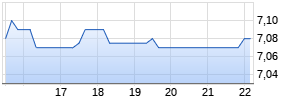
Ellington Residential Mortgage REIT Reports Second Quarter 2016 Results
PR Newswire
OLD GREENWICH, Conn., Aug. 2, 2016
OLD GREENWICH, Conn., Aug. 2, 2016 /PRNewswire/ -- Ellington Residential Mortgage REIT (NYSE: EARN) today reported financial results for the quarter ended June 30, 2016.
Summary of Financial Results
- Net income for the quarter was $3.5 million, or $0.38 per share, as compared to net loss of $(0.2) million, or $(0.03) per share, in the first quarter.
- Core Earnings1 for the quarter was $2.9 million, or $0.32 per share, as compared to $4.9 million, or $0.53 per share, in the first quarter. Excluding "Catch-up Premium Amortization Adjustment," Core Earnings for the second quarter was $4.4 million, or $0.48 per share, as compared to $4.6 million, or $0.50 per share, in the first quarter.
- Book value decreased slightly to $15.38 per share as of June 30, 2016 from $15.39 per share as of March 31, 2016, after giving effect to a second quarter dividend of $0.40 per share.
- Net interest margin was 1.28%, as compared to 1.92% for the first quarter. Excluding Catch-up Premium Amortization Adjustment, net interest margin was 1.76% for the second quarter of 2016 as compared to 1.83% for the first quarter.
- Weighted average prepayment speed for fixed rate Agency specified pools was 10.1% CPR for the quarter, as compared to 7.1% in the first quarter.
- Dividend yield of 11.1% based on August 1, 2016 closing stock price of $14.43.
- Debt-to-equity ratio was 8.6:1 as of June 30, 2016, as compared to 8.1:1 as of March 31, 2016. Adjusted for unsettled purchases and sales, the debt-to-equity ratio was 8.1:1 and 7.7:1 as of June 30, 2016 and March 31, 2016, respectively.
1 Core Earnings is a non-GAAP financial measure. See "Reconciliation of Core Earnings to Net Income (Loss)" below for an explanation regarding the calculation of Core Earnings.
Second Quarter 2016 Results
"For the second quarter of 2016, EARN had net income of $0.38 per share and Core Earnings excluding Catch-up Premium Amortization Adjustment of $0.48 per share," said Laurence Penn, Chief Executive Officer and President. "Over the course of the second quarter, our Agency specified pools performed well against the backdrop of declining interest rates. The second quarter culminated in significant volatility following the June 23rd 'Brexit' vote, and resulted in substantially lower or even negative yields on the highest credit-quality sovereign debt. Consequently, investor demand for Agency RMBS, given their liquidity, credit quality, and higher yields, has been strong, particularly from foreign investors. This helped propel prices on our specified pools, as did the attractiveness of their inherent prepayment protection characteristics.
"With the significant decline in interest rates that occurred towards the end of the second quarter, our expectation is that prepayment activity will pick up in the coming months, and we believe that our portfolio is well positioned for such activity. We also believe that the Agency RMBS market remains an attractive alternative for investors seeking high credit-quality assets that still offer meaningfully positive yields. Still, the strength of the U.S. economy may lead the Federal Reserve to resume increasing interest rates, although both the timing and pace of any such increases have become more uncertain given the global macroeconomic environment. As always, we continue to actively hedge our portfolio against the risk of rising interest rates.
"During the second quarter, we also had strong results from our small non-Agency RMBS portfolio, which produced not only strong carry, but also had solid contributions from asset appreciation and trading."
As of June 30, 2016, our mortgage-backed securities portfolio consisted of $1.079 billion of fixed rate Agency "specified pools," $43.3 million of Agency RMBS backed by adjustable rate mortgages, or "Agency ARMs," $76.1 million of Agency reverse mortgage pools, $7.6 million of Agency interest only securities, or "Agency IOs," and $22.8 million of non-Agency RMBS. Specified pools are fixed rate Agency pools with special characteristics, such as pools comprised of low loan balance mortgages, pools comprised of mortgages backed by investor properties, pools containing mortgages originated through the government-sponsored "Making Homes Affordable" refinancing programs, and pools containing mortgages with various other characteristics. During the quarter, we modestly increased our holdings of pass-through pools backed by fixed rate as well as adjustable rate mortgages. Overall, the size of our RMBS portfolio increased to $1.229 billion as of June 30, 2016, from $1.174 billion as of March 31, 2016. In addition, separate and apart from the short TBA portfolio that we hold for hedging purposes, we held $63.8 million in notional amount of long TBA positions for investment purposes at June 30, 2016, as compared to $76.9 million at March 31, 2016. For financial reporting purposes, TBAs are considered derivative instruments.
Market Overview
Over the first two months of the second quarter, interest rates generally trended slightly higher and volatility declined. However, during the month of June, as a result of the United Kingdom's vote to leave the European Union, or the "Brexit" vote, and the ensuing concerns around its ultimate impact on the global economy, interest rates sharply reversed course and dropped dramatically. Market participants were generally caught off guard with respect to the outcome of the vote which, in turn, fueled demand for U.S. Treasury and other safe haven securities, such as Agency RMBS. The relative yields and liquidity of these instruments increased what had been already high investor demand for them. For most credit sensitive assets, such as non-Agency RMBS and high-yield corporate credit, yield spreads initially widened in reaction to the Brexit vote. However, this widening was short-lived, as investors were emboldened by the quick response from a number of major central banks indicating that global central bank monetary policy would continue to be highly accommodative in the face of Brexit-related uncertainty. Sharply lower yields on safe haven securities also pushed many global investors to add to their credit-sensitive portfolios. As a result of these factors, credit spreads generally ended the quarter tighter than where they had begun the quarter, although some credit-sensitive sectors, such as CMBS, experienced some degree of net widening for the quarter.
Since its December 2015 initial increase in the target range for the federal funds rate, which followed a long period of monetary policy easing actions, the Federal Reserve has not announced any additional interest rate increases. Concerns around a global economic slowdown, as well as mixed data regarding the state of the U.S. economy, have led the Federal Reserve to delay the timing and expected pace of increases in the target range. However, as market developments occur, speculation about when the Federal Reserve will resume its plan to increase rates continues to be a significant factor in the volatility and direction of interest rates.
The yield curve flattened significantly over the course of the second quarter, as the 10-year U.S. Treasury yield fell 30 basis points to 1.47%, while the 2-year U.S. Treasury yield fell 14 basis points to 0.58%. All of the yield declines, and most of the yield curve flattening, were concentrated in last week of June following the Brexit vote. The average rate for a fixed rate 30-year conventional mortgage fell 23 basis points over the course of the quarter, and ended the quarter at 3.48%, its lowest level since May 2013. In addition, the Mortgage Bankers Association US Refinancing Index, a metric that tracks the volume of mortgage loan applications that have been submitted to lenders, increased sharply around quarter end, indicating an increase in refinancing activity.
Agency RMBS
Prices of Agency RMBS increased over the course of the second quarter, and yield spreads on Agency RMBS relative to interest rate swaps and U.S. Treasury securities were relatively stable. While the 10-year interest rate swap spread to U.S. Treasury securities continued to be negative at the end of the second quarter, it was negative 11 basis points, or 2 basis points less negative than at March 31, 2016, finally reversing its tightening trend of the last several quarters. Since a significant portion of our interest rate hedging portfolio is comprised of interest rate swaps, this positively impacted our results for the quarter. In addition, pay-ups on specified pools increased as prepayment protection became more valuable in light of lower interest rates and expected increases in prepayment rates. Performance of specified pools meaningfully augmented our results for the second quarter.
For the quarter ended June 30, 2016, we had total net realized and unrealized gains of $8.7 million, or $0.95 per share, on our aggregate Agency RMBS portfolio, while we had total net realized and unrealized losses of $9.6 million, or $1.05 per share, on our interest rate hedging portfolio, including U.S. Treasury securities. Over the course of the second quarter, average pay-ups on our specified pools increased to 1.03% as of June 30, 2016, from 0.88% as of March 31, 2016. Pay-ups are price premiums for specified pools relative to their TBA counterparts.
During the second quarter, we continued to use short positions in TBAs to hedge interest rate risk, and these positions generated net losses as interest rates fell. TBA dollar rolls materially weakened in response to both the increase in prepayment speeds and the slowly shrinking presence of the Federal Reserve in the market. In addition, TBAs materially underperformed specified pools as many investors sought out pools with better prepayment protection. Because we hold a net short position in TBAs against our long position in specified pools, this underperformance of TBAs relative to specified pools benefited our results for the quarter. As trading volumes for specified pools expand, and to the extent prepayments remain elevated, we believe that the underperformance of generic pools relative to specified pools will persist. During the quarter, we increased our net short TBAs and reduced our interest rate swaps.
We actively traded our Agency RMBS portfolio during the quarter in order to take advantage of volatility and to harvest modest gains. Our portfolio turnover for the quarter was 31% (as measured by sales and excluding paydowns), and we captured net realized gains of $2.5 million, excluding hedges.
During the second quarter, we continued to focus our Agency RMBS purchasing activity primarily on specified pools, especially those with higher coupons. As of June 30, 2016, the weighted average coupon on our fixed rate specified pools was 4.0%, relatively unchanged from March 31, 2016. During the second quarter, we increased our holdings of Agency pools following their significant yield spread widening during the first quarter of 2016. Our Agency RMBS portfolio also continues to include a small allocation to Agency IOs, which we increased slightly during the quarter. We continue to believe reverse mortgage pools represent an attractive asset class. Reverse mortgage pools tightened throughout the second quarter, largely in response to lower prepayment speeds, which were primarily the result of the anti-churning guidelines issued last October by the National Reverse Mortgage Lenders' Association. Overall, we believe that there remains a heightened risk of substantial interest rate and mortgage prepayment volatility in the near term, thus reinforcing the importance of our ability to hedge our Agency RMBS portfolio using a variety of tools, including TBAs.
We expect to continue to target specified pools that, taking into account their particular composition and based on our prepayment projections: (1) should generate attractive yields relative to other Agency RMBS and U.S. Treasury securities, (2) should have less prepayment sensitivity to government policy shocks, and/or (3) should create opportunities for trading gains once the market recognizes their value, which for newer pools may come only after several months, when actual prepayment experience can be observed. We believe that our research team, proprietary prepayment models, and extensive databases remain essential tools in our implementation of this strategy.
Our net Agency premium as a percentage of our long Agency RMBS holdings is one metric that we use to measure our overall prepayment risk. Net Agency premium represents the total premium (excess of market value over outstanding principal balance) on long Agency RMBS holdings less the total premium on related net short TBA positions. The lower our net Agency premium, the less we believe we are exposed to market-wide increases in Agency RMBS prepayments. As of June 30, 2016, our net Agency premium as a percentage of fair value on long Agency RMBS holdings was approximately 5.2% as compared to 5.6%, as of March 31, 2016. Excluding TBA positions used to hedge our long Agency RMBS portfolio, our Agency premium as a percentage of fair value was approximately 7.7% and 7.3% as of June 30, 2016 and March 31, 2016, respectively. These percentages may fluctuate from period to period based on market factors, including interest rates and mortgage rates, as well as with respect to the net percentages, the degree to which we hedge prepayment risk with short TBAs. We believe that our focus on purchasing pools with specific prepayment characteristics provides a measure of protection against prepayments.
We believe that with the recent drop in interest rates, prepayment concerns should continue to benefit the relative performance of specified pools, and could create more attractive opportunities in the IO markets. We believe that our adaptive and active style of portfolio management is well suited to the current MBS market environment, which continues to be shaped by shifting central bank policies, regulatory changes, and developing technologies.
Non-Agency RMBS
Non-Agency RMBS performed well during the second quarter, despite uncertainty and credit spread volatility brought on by the Brexit vote. As the case has been for some time, the fundamentals underlying non-Agency RMBS, led by a stable housing market, continue to be strong. Included in the quarter's return were strong carry, appreciation from our held positions, and net realized gains from positions sold. On a quarter-over-quarter basis, our non-Agency RMBS portfolio declined in size. As of June 30, 2016, our investment in non-Agency RMBS was $22.8 million as compared to $27.6 million as of March 31, 2016. The size of this portfolio may fluctuate on a quarter-over-quarter basis. Additionally, to the extent more attractive entry points develop in non-Agency RMBS, we may increase our capital allocation to this sector.
Financial Results
For the quarter ended June 30, 2016, the weighted average yield of our portfolio of Agency and non-Agency RMBS was 2.45%, while our average cost of funds including interest rate swaps and U.S. Treasuries was 1.17%, resulting in a net interest margin for the quarter of 1.28%. In comparison, for the quarter ended March 31, 2016, the annualized weighted average yield of our Agency and non-Agency RMBS was 3.13%, while the average cost of funds including interest rate swaps and U.S. Treasuries was 1.21%, resulting in a net interest margin of 1.92%. Our interest income is subject to fluctuations based on adjustments to premium amortization as a result of changes in prepayments of our Agency RMBS (accompanied by a corresponding offsetting adjustment to realized and unrealized gains and losses). We refer to this adjustment as a "Catch-up Premium Amortization Adjustment." The amount of this adjustment can vary significantly from quarter to quarter. During the second quarter, we had a negative Catch-up Premium Amortization Adjustment in the amount of approximately $1.5 million, which decreased our net interest income. Excluding the Catch-up Premium Amortization Adjustment, our weighted average yield on our portfolio was 2.93% and our net interest margin was 1.76%. During the quarter ended March 31, 2016, the Catch-up Premium Amortization Adjustment increased interest income by approximately $0.3 million. Excluding this Catch-up Premium Amortization Adjustment, the weighted average yield on our portfolio for the quarter ended March 31, 2016 would have been 3.04% and our net interest margin would have been 1.83%.
On a quarter-over-quarter basis our annualized cost of funds, including interest rate swaps and short positions in U.S. Treasury securities, decreased to 1.17% from 1.21%. This net decrease was the result of largely offsetting factors. First, the average cost of our repo, which represents the largest component of our cost of funds, increased 8 basis points to 0.70%. However, the impact of this increase was offset by a combined decline in the average cost of our interest rate swaps and U.S. Treasury hedges, which decreased 12 basis points to 0.47%. While Agency repo rates declined slightly in the early part of the quarter, they reversed course and rose slightly as dealer balance sheets came under pressure as quarter end approached. In the final week of the quarter, uncertainty following the Brexit vote caused a spike in repo rates, although following quarter end repo rates have generally settled back to where they had been at the beginning of the second quarter. We have continued to find repo readily available. Over the course of the quarter, we reduced our interest rate swaps in favor of short TBAs, leading to a decline in our cost of funds. The relative make up of our interest rate hedging portfolio can change materially from quarter to quarter.
After giving effect to a second quarter dividend of $0.40 per share, our book value per share was $15.38 as of June 30, 2016, slightly below our book value per share as of March 31, 2016 of $15.39, and we had an economic return of 2.5% for the quarter. Economic return on book value is computed by adding back dividends to ending book value per share, and comparing that amount to book value per share as of the beginning of the quarter.
For the quarter ended June 30, 2016, Core Earnings was $2.9 million, or $0.32 per share, as compared to $4.9 million, or $0.53 per share for the quarter ended March 31, 2016. Core Earnings is a non-GAAP financial measure. The decrease in our Core Earnings quarter over quarter was primarily the result of the quarter-over-quarter change in the Catch-up Premium Amortization Adjustment. See "Reconciliation of Core Earnings to Net Income (Loss)" below for an explanation regarding the calculation of Core Earnings, and Core Earnings excluding Catch-up Premium Amortization Adjustment.
Securities Portfolio
The following table summarizes our portfolio of securities as of June 30, 2016 and March 31, 2016:
| | June 30, 2016 | | March 31, 2016 | ||||||||||||||||||||||||||||||||||||
| (In thousands) | Current Principal | | Fair Value | | Average | | Cost | | Average | | Current | | Fair Value | | Average | | Cost | | Average | ||||||||||||||||||||
| Agency RMBS(2) | | | | | | | | | | | | | | | | | | | | ||||||||||||||||||||
| 15-year fixed rate mortgages | $ | 133,590 | | | $ | 142,365 | | | $ | 106.57 | | | $ | 140,303 | | | $ | 105.03 | | | $ | 143,705 | | | $ | 152,536 | | | $ | 106.15 | | | $ | 150,945 | | | $ | 105.04 | |
| 20-year fixed rate mortgages | 11,061 | | | 12,014 | | | 108.62 | | | 11,920 | | | 107.77 | | | 17,991 | | | 19,488 | | | 108.32 | | | 19,226 | | | 106.86 | | ||||||||||
| 30-year fixed rate mortgages | 851,353 | | | 924,824 | | | 108.63 | | | 908,300 | | | 106.69 | | | 788,135 | | | 852,326 | | | 108.14 | | | 840,998 | | | 106.71 | | ||||||||||
| ARMs | 41,005 | | | 43,337 | | | 105.69 | | | 43,143 | | | 105.21 | | | 35,122 | | | 37,133 | | | 105.73 | | | 37,232 | | | 106.01 | | ||||||||||
| Reverse mortgages Werbung Mehr Nachrichten zur Ellington Residential Mortgage Reit Aktie kostenlos abonnieren
E-Mail-Adresse
Bitte überprüfe deine die E-Mail-Adresse.
Benachrichtigungen von ARIVA.DE (Mit der Bestellung akzeptierst du die Datenschutzhinweise) -1  Vielen Dank, dass du dich für unseren Newsletter angemeldet hast. Du erhältst in Kürze eine E-Mail mit einem Aktivierungslink. Hinweis: ARIVA.DE veröffentlicht in dieser Rubrik Analysen, Kolumnen und Nachrichten aus verschiedenen Quellen. Die ARIVA.DE AG ist nicht verantwortlich für Inhalte, die erkennbar von Dritten in den „News“-Bereich dieser Webseite eingestellt worden sind, und macht sich diese nicht zu Eigen. Diese Inhalte sind insbesondere durch eine entsprechende „von“-Kennzeichnung unterhalb der Artikelüberschrift und/oder durch den Link „Um den vollständigen Artikel zu lesen, klicken Sie bitte hier.“ erkennbar; verantwortlich für diese Inhalte ist allein der genannte Dritte. Andere Nutzer interessierten sich auch für folgende News | |||||||||||||||||||||||||||||||||||||||





